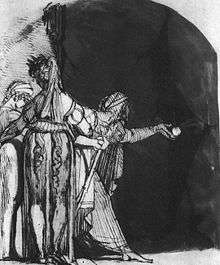Graeae
In Greek mythology the Graeae (/ˈɡraɪiː/; English translation: "old women", "grey ones", or "grey witches"; alternatively spelled Graiai (Γραῖαι) and Graiae), also called the Grey Sisters and the Phorcides ("daughters of Phorcys"),[1] were three sisters who shared one eye and one tooth among them. Their names were Deino (or Dino), Enyo, and Pemphredo (or Pephredo).

Etymology
The word Graeae is probably derived from the adjective γραῖα graia "old woman", derived from the Proto-Indo-European root *ǵerh2-/*ǵreh2-, "to grow old" via Proto-Greek *gera-/grau-iu.[2]
Mythology

The Graeae were daughters of the sea-deities Phorcys and Ceto (from which their name the Phorcydes derived) and sisters to the Gorgons.[3] The Graeae took the form of old, grey-haired women. Their age was so great that a human childhood for them was hardly conceivable. In Theogony, however, Hesiod describes the Graeae as being "fair-cheeked". In Prometheus Bound, the Graeae are described as being swan-shaped ("κυκνόμορφοι")[4]
Hesiod names only two Graeae, the "well-clad" Pemphredo (Πεμφρηδώ "alarm") and the "saffron-robed" Enyo (Ἐνυώ "horror" the "waster of cities" who also had an identity separate from this sisterhood).[5] Pseudo-Apollodorus lists Deino (Δεινώ "dread", the dreadful anticipation of horror) as a third.[6] Calling them "Phorcides", Hyginus, in addition to Pemphredo and Enyo, adds Persis noting that "for this last others say Dino".[7]
They shared one eye and one tooth, which they took turns using. By stealing their eye while they were passing it among themselves, the hero Perseus forced them to tell the whereabouts of the three objects needed to kill Medusa (in other versions the whereabouts of Medusa) by ransoming their shared eye for the information.[3]
Genealogy
| Gaia | |||||||||||||||||||||||||||||||||||||||||||||||||||||||||||||||||||||
| Pontus | Thalassa | ||||||||||||||||||||||||||||||||||||||||||||||||||||||||||||||||||||
| Nereus | Thaumas | Phorcys | Ceto | Eurybia | The Telchines | Halia | Aphrodite [8] | ||||||||||||||||||||||||||||||||||||||||||||||||||||||||||||||
| Echidna | The Gorgons | The Graeae | Ladon | The Hesperides | Thoosa[9] | ||||||||||||||||||||||||||||||||||||||||||||||||||||||||||||||||
| Stheno | Deino | ||||||||||||||||||||||||||||||||||||||||||||||||||||||||||||||||||||
| Euryale | Enyo | ||||||||||||||||||||||||||||||||||||||||||||||||||||||||||||||||||||
| Medusa[10] | Pemphredo | ||||||||||||||||||||||||||||||||||||||||||||||||||||||||||||||||||||
Notes
- Sommerstein, p. 260, in Aeschylus. Fragments; Aeschylus, Prometheus Bound 790–800 (pp. 530–531) with n. 94; Apollodorus, 1.2.6; Hyginus, Fabulae Preface.
- R. S. P. Beekes, Etymological Dictionary of Greek, Brill, 2009, p. 285.
- Harris, Stephen L., and Gloria Platzner. Classical Mythology: Images and Insights (Third Edition). California State University, Sacramento. Mayfield Publishing Company. 2000, 1998, 1995, pp. 273–274, 1039.
- Aeschylus, Prometheus Bound, 795.
- Hesiod, Theogony, 270-274.
- Pseudo-Apollodorus, Bibliotheca 2.4.2; Pemphredo, sometimes also spelled Peuphredo (Πευφρηδώ) or Pephredo (Πεφρηδώ) (see M. Hofinger, Lexicon Hesiodeum cum Indice Inverso, p. 533.
- Hyginus, Fabulae Preface.
- There are two major conflicting stories for Aphrodite's origins: Hesiod (Theogony) claims that she was "born" from the foam of the sea after Cronus castrated Uranus, thus making her Uranus' daughter; but Homer (Iliad, book V) has Aphrodite as daughter of Zeus and Dione. According to Plato (Symposium 180e), the two were entirely separate entities: Aphrodite Ourania and Aphrodite Pandemos.
- Homer, Odyssey, 1.70–73, names Thoosa as a daughter of Phorcys, without specifying a mother.
- Most sources describe Medusa as the daughter of Phorcys and Ceto, though the author Hyginus (Fabulae Preface) makes Medusa the daughter of Gorgon and Ceto.
References
- Apollodorus, Apollodorus, The Library, with an English Translation by Sir James George Frazer, F.B.A., F.R.S. in 2 Volumes. Cambridge, Massachusetts, Harvard University Press; London, William Heinemann Ltd. 1921. Online version at the Perseus Digital Library.
- Aeschylus. Fragments. Edited and translated by Alan H. Sommerstein. Loeb Classical Library No. 505. Cambridge, Massachusetts: Harvard University Press, 2009. ISBN 978-0-674-99629-8. Online version at Harvard University Press
- Aeschylus, Persians. Seven against Thebes. Suppliants. Prometheus Bound. Edited and translated by Alan H. Sommerstein. Loeb Classical Library No. 145. Cambridge, Massachusetts: Harvard University Press, 2009. ISBN 978-0-674-99627-4. Online version at Harvard University Press
- Apollodorus, Apollodorus, The Library, with an English Translation by Sir James George Frazer, F.B.A., F.R.S. in 2 Volumes. Cambridge, Massachusetts, Harvard University Press; London, William Heinemann Ltd. 1921. Online version at the Perseus Digital Library.
- Grimal, Pierre, The Dictionary of Classical Mythology, Wiley-Blackwell, 1996, ISBN 978-0-631-20102-1. "Graeae" p. 175.
- Hesiod, Theogony, in The Homeric Hymns and Homerica with an English Translation by Hugh G. Evelyn-White, Cambridge, Massachusetts., Harvard University Press; London, William Heinemann Ltd. 1914. Online version at the Perseus Digital Library.
- Hyginus, Gaius Julius, The Myths of Hyginus. Edited and translated by Mary A. Grant, Lawrence: University of Kansas Press, 1960.
- Smith, William; Dictionary of Greek and Roman Biography and Mythology, London (1873). "Graeae"